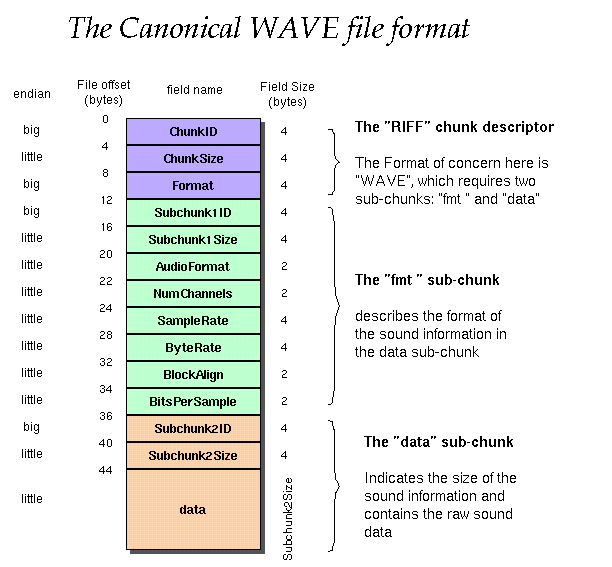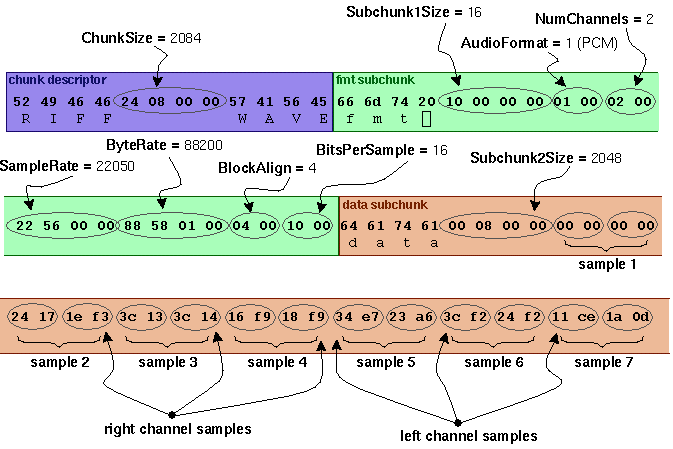WAV File Format Header
WAVE PCM soundfile format
The WAVE file format is a subset of Microsoft's RIFF specification for the storage of multimedia files. A RIFF file starts out with a file header followed by a sequence of data chunks. A WAVE file is often just a RIFF file with a single "WAVE" chunk which consists of two sub-chunks -- a "fmt " chunk specifying the data format and a "data" chunk containing the actual sample data. Call this form the "Canonical form". Who knows how it really all works.
I use the standard WAVE format as created by the sox program:

Offset Size Name Description
The canonical WAVE format starts with the RIFF header: 0 4 ChunkID Contains the letters "RIFF" in ASCII form (0x52494646 big-endian form). 4 4 ChunkSize 36 + SubChunk2Size, or more precisely: 4 + (8 + SubChunk1Size) + (8 + SubChunk2Size) This is the size of the rest of the chunk following this number. This is the size of the entire file in bytes minus 8 bytes for the two fields not included in this count: ChunkID and ChunkSize. 8 4 Format Contains the letters "WAVE" (0x57415645 big-endian form). The "WAVE" format consists of two subchunks: "fmt " and "data": The "fmt " subchunk describes the sound data's format: 12 4 Subchunk1ID Contains the letters "fmt " (0x666d7420 big-endian form). 16 4 Subchunk1Size 16 for PCM. This is the size of the rest of the Subchunk which follows this number. 20 2 AudioFormat PCM = 1 (i.e. Linear quantization) Values other than 1 indicate some form of compression. 22 2 NumChannels Mono = 1, Stereo = 2, etc. 24 4 SampleRate 8000, 44100, etc. 28 4 ByteRate == SampleRate * NumChannels * BitsPerSample/8 32 2 BlockAlign == NumChannels * BitsPerSample/8 The number of bytes for one sample including all channels. I wonder what happens when this number isn't an integer? 34 2 BitsPerSample 8 bits = 8, 16 bits = 16, etc. 2 ExtraParamSize if PCM, then doesn't exist X ExtraParams space for extra parameters The "data" subchunk contains the size of the data and the actual sound: 36 4 Subchunk2ID Contains the letters "data" (0x64617461 big-endian form). 40 4 Subchunk2Size == NumSamples * NumChannels * BitsPerSample/8 This is the number of bytes in the data. You can also think of this as the size of the read of the subchunk following this number. 44 * Data The actual sound data.
As an example, here are the opening 72 bytes of a WAVE file with bytes shown as hexadecimal numbers:
52 49 46 46 24 08 00 00 57 41 56 45 66 6d 74 20 10 00 00 00 01 00 02 00 22 56 00 00 88 58 01 00 04 00 10 00 64 61 74 61 00 08 00 00 00 00 00 00 24 17 1e f3 3c 13 3c 14 16 f9 18 f9 34 e7 23 a6 3c f2 24 f2 11 ce 1a 0d
Here is the interpretation of these bytes as a WAVE soundfile:

Notes:
- The default byte ordering assumed for WAVE data files is little-endian. Files written using the big-endian byte ordering scheme have the identifier RIFX instead of RIFF.
- The sample data must end on an even byte boundary. Whatever that means.
- 8-bit samples are stored as unsigned bytes, ranging from 0 to 255. 16-bit samples are stored as 2's-complement signed integers, ranging from -32768 to 32767.
- There may be additional subchunks in a Wave data stream. If so, each will have a char[4] SubChunkID, and unsigned long SubChunkSize, and SubChunkSize amount of data.
- RIFF stands for Resource Interchange File Format.
General discussion of RIFF files:
Multimedia applications require the storage and management of a wide variety of data, including bitmaps, audio data, video data, and peripheral device control information. RIFF provides a way to store all these varied types of data. The type of data a RIFF file contains is indicated by the file extension. Examples of data that may be stored in RIFF files are:- Audio/visual interleaved data (.AVI)
- Waveform data (.WAV)
- Bitmapped data (.RDI)
- MIDI information (.RMI)
- Color palette (.PAL)
- Multimedia movie (.RMN)
- Animated cursor (.ANI)
- A bundle of other RIFF files (.BND)
For more info see http://www.ora.com/centers/gff/formats/micriff/index.htm
References:
- http://netghost.narod.ru/gff/graphics/summary/micriff.htm RIFF Format Reference (good).
- http://www.lightlink.com/tjweber/StripWav/WAVE.html
출처 : http://ccrma.stanford.edu/courses/422/projects/WaveFormat/
'Programing 미분류' 카테고리의 다른 글
| Scheme (0) | 2008.03.05 |
|---|---|
| HMD 와 블루투스 및 기울기 센서를 이용한 3D 게임 (0) | 2008.01.02 |
| File Header (0) | 2007.12.05 |



